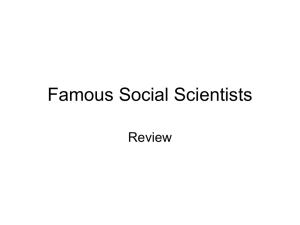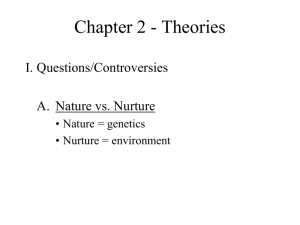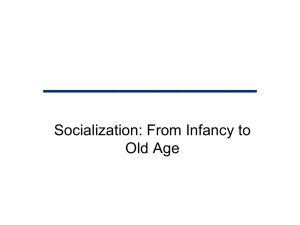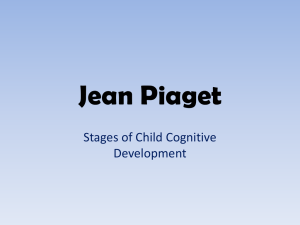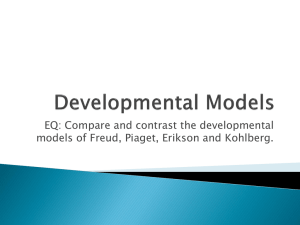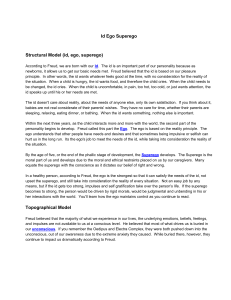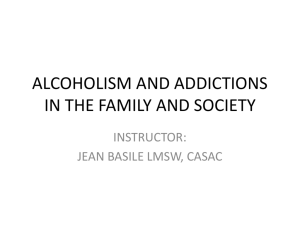Socialization & Perception
advertisement
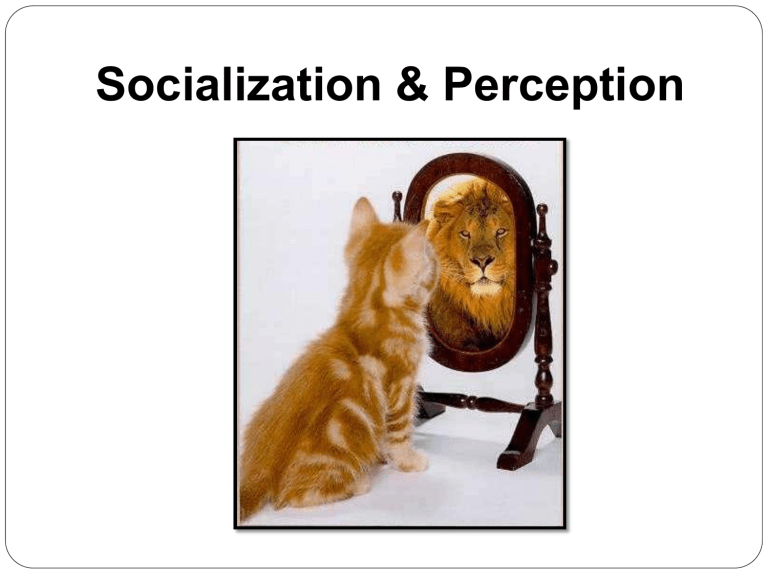
Socialization & Perception Perception of people in our class How do you appear in the eyes of those around you? (List characteristics or qualities that others would use to describe you) Areas to Consider: Personality Popularity Intelligence Skills Activities Interests/Hobbies Goals Friendship Clothing Appearance Now, we’ll see how others perceive us. Put your name at the top of a piece of notebook paper. We’ll take a few minutes to pass the sheets around Only POSITIVE responses…If you do not have anything positive to say, don’t write anything down! SILLY POPULAR SMART SHY Questions to Ponder: 1. Does the perception/opinion of your peers reinforce what you already knew or does it change your perception in a certain area(s)? 2. Do you think or care about what other people think of you? 3. Are these accurate descriptions? Socialization into the Self and Mind Charles Cooley (sociologist/professor at Univ. of Michigan) said, “our sense of self develops from interaction with others” Cooley coined the term “looking glass self” the process by which our self develops through internalizing others’ reactions to us 1. We imagine how we appear to those around us 2. We interpret others’ reactions (opinions) 3. We develop a self concept teachers, coaches, boss, other family members Things to Consider: Development of “self” is not always accurate We sometime misinterpret how others think about us Self concept is ongoing, lifelong process We monitor how other react to us (think of us) and modify ourselves Childhood Development: George H. Mead & Taking the Role of the Other •Mead agree with Cooley; however, he also felt a person needs to understand others to develop a concept of themselves and who they want to be. In order to do this, Mead believed people need to put themselves into the shoes of someone else to completely understand how someone feels and thinks thus anticipating how that person will act. Mead’s 3 Stages for “Taking the Role of Others” Three stages of development: 1. Preparatory stage (under 3 years) - child imitates basic behaviors without understanding 2. Play stage (3 – 6 years) - imitates and understands the role of the “significant other” (e.g. children play at being parents, doctors, police office, etc.) 3. Game stage (6 +) - imitates and understands the role of “generalized other” (children understand rules of game, different positions, etc.) Play Stage Playing “cops & robbers” or “doctor & patient” Understands the roles of each “significant other”, but is limited in the roles they can play Game Stage Child must understand the role of not only themselves, but of those around him/her E.g. baseball: A little boy playing 1st base on a tee-ball team must be able to anticipate what the pitcher will do, what the hitter will do, what the catcher will do, and respond accordingly (the “generalized others”) Learn: the function of the organization (team) and the role they play in the organization (position) Cognitive Development Piaget’s Stages of Childhood Development Jean Piaget Swiss Philosopher and psychologist… focused on epistemology Piaget studied the natural process of how children learn to reason; after years of testing Piaget concluded children clearly go through 4 stages to develop their ability to reason •Studied his own children to better understand Basic Theories… 1. The child used "schemas" to master and gain information about the environment 2. The sophistication of a child's cognitive structures increase as the child grows and develops, as does the child’s schemas We understand the world through schemas…e.g. rattles We assimilate new objects into preexisting schemas…e.g. dad’s watch We accommodate objects that do not fit by changing our schemas…e.g. beach balls Piaget’s 4 Stages of Development 1. Sensorimotor Stage (infancy) 2. Preoperational Stage (pre-school) 3. Concrete Operational Stage (childhood) 4. Formal Operational Stage (adolescence) Sensorimotor Stage Birth to Age 2 Child interacts with environment through physical actions (sucking, pushing, grabbing, shaking, etc.) These interactions build the child's cognitive structures about the world and how it functions or responds. Peek-a-boo Out of sight out of mind…or at least existence The here and now is all that exists for infants Object Permanence is discovered (things still exist while out of view). Emerges between the ages of 7-12 months Representational Thought 18-24 months: children will begin to visualize something they’ve seen or experienced in their mind Preoperational Stage Ages 2-7 Understands past and present Symbols develop however children do not understand common concepts such as size or causation Conservation - a given quantity does not change even when its appearance is changed This is why - according to Piaget, children are egocentric - they have no sense of varied perspectives (cannot take the role of the other) Preoperational Stage Egocentrism Concrete Operational (Reasoning) Stage Ages 7-12 Reasoning abilities are more developed, but remain concrete Can now understand numbers, size, causation Can take the role of the other Classification & Seriation (ability to sort by size) Reversibility - can identify relationships between categories Formal Operational (reasoning) Stage Age 12 - adulthood Deductive Reasoning / Hypothetical Thinking Abstract thought & problem solving Development of Personality Testing Personalities Aim to assess characteristics and identify psychological disorders Objective vs. Projective Objective tests provide a limited number of questions with responses - paper or computer based Projective tests are unstructured and require interpretation on the part of the person being tested Where do you fall on the Big 5? Log on to the computer and navigate to the following website: http://www.personalitytest.org.uk/ Take the 41 question survey and write down your results for each of the 5 categories Rorschach Inkblot Tests Hermann Rorschach How is the test implemented? Psychiatrist will have a patient look at 10 inkblots individually. The cards are placed in your hands in the sequence I will show you. You are told you can do whatever you like with the cards and to respond as to what you see. The psychiatrists will take notes as you respond. 1. 3. 4. 5. Examining the Results: Your responses should not be overly sexual, or negative…for instance, it is better to see two rabbits playing than two vampires fighting. Butterflies, people holding hands, leaves, mountains, etc are all generally considered to be “safe” responses The Thematic Apperception Test The “TAT” Test TAT Tests Thematic Apperception Test is an example of a projective test. The test claims to tap a subject's unconscious to reveal repressed aspects of personality motives and needs for achievement power and intimacy problem-solving abilities Write A Story… For the next 5-7 minutes, I will show you a picture. You need to write a story about what you fantasize the picture is about… What has led up to the event shown ? What is happening at the moment ? What the characters are feeling and thinking, and ? What the outcome of the story was.? Sigmund Freud was an Austrian physician who founded the psychoanalytic school of psychiatry. Freud believed personality consisted of 3 elements: The Id The Ego The Superego The Id – inborn drives (impulses) that seek self gratification The id is pleasure seeking: Food – Sex - Attention The Superego – the conscience (our moral part) Provokes guilt/shame or pride/satisfaction The Ego – part of personality that maintains balance between our impulses (id) and our conscience (superego) The ego balances the id so we aren’t out of control from our inborn drives but also keeps the superego in check so we aren’t to stringent or rigid The Office: Michael: id (childish and impulsive) Dwight: superego (moralistic) Jim: ego (sensible and balance – drive the office) Two and a Half Men: Charlie: id (pleasure seeking lifestyle) Alan: Superego (straight-laced) Jake: ego (stuck in the middle) Freud and Sociology Sociologists object to Freud’s view that inborn and subconscious motivations are the primary reason for human behavior This contrasts the basic ideas of sociology Moral Development Lawrence Kohlberg Expands on Piaget – focuses on moral development Identifies stages that we move through as “moral” social beings 4. Post-Conventional Stage 3. Conventional Stage 2. Pre-Conventional Stage 1. Amoral Stage Moral Development Amoral Stage 1. 2. 3. Totally egocentric No concept of moral right or wrong Kids want to be fulfilled regardless of the moral cost. Pre-Conventional Stage Kids learn a fear of punishment/obedience Focus is on selfinterest Usually develops in early childhood (preschool) Conventional Stage Kids learn to conform to others Rules and laws are upheld based on norms Obedience without question Usually begins around middle school Post-Conventional Stage “The Social Contract” Young adults develop their own ideas on important issues Alternatives (from parents) are considered Ideas are based on accepted principles Usually occurs around collegeage 1.Tamara has five tests in one day. She is a good student but did not have time to study for her French test. She knows the person next to her is also a good student. This girl has copied from Tamara on occasion. Tamara decides to look at the other girl’s test for the questions she doesn’t know. Besides, thinks Tamara, “I never should have five tests in one day anyways.” 2. Scott thought about leaving school early and going to a baseball game. He stayed in school because he was afraid of getting caught. 3. Juanita’s friends were at the mall, and someone suggested they do a little shoplifting just to see if they could get away with It. Juanita wouldn’t participate and said stealing is wrong. 4. Muhammad lives with his mother in a poor section of the city. His mother is quite Ill and needs outpatient services daily at a hospital some miles away from their home. Muhammad steals a car to take his mother to the hospital. 5. Martina, a young woman living in a war-torn region of the world, distributes food to orphans living In the streets. This activity is actually against the law. She frequently has to deceive the authorities In order to keep these children alive. 6. Grant wants to spend time after school volunteering at the hospital. However, he is a good basketball player, and practice interferes with this volunteer program. The coach and other teammates pressure him to play. Grant decides to play with the team.
